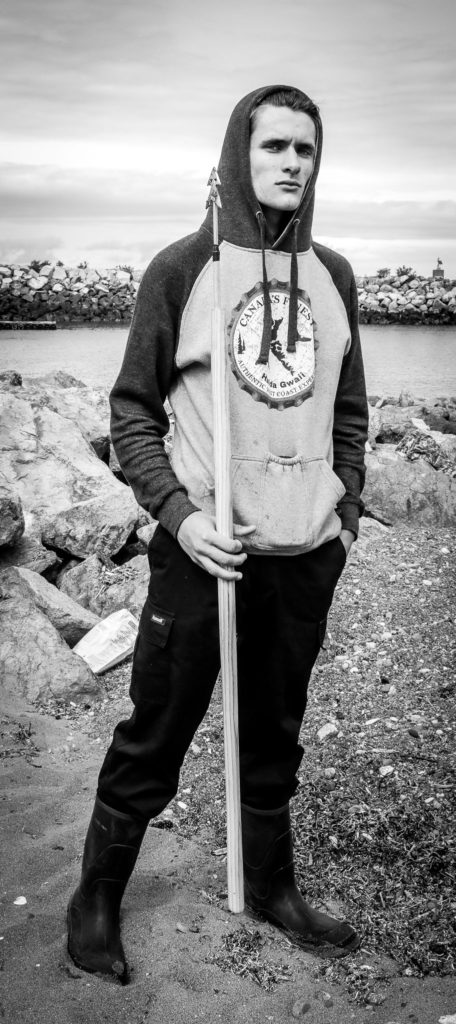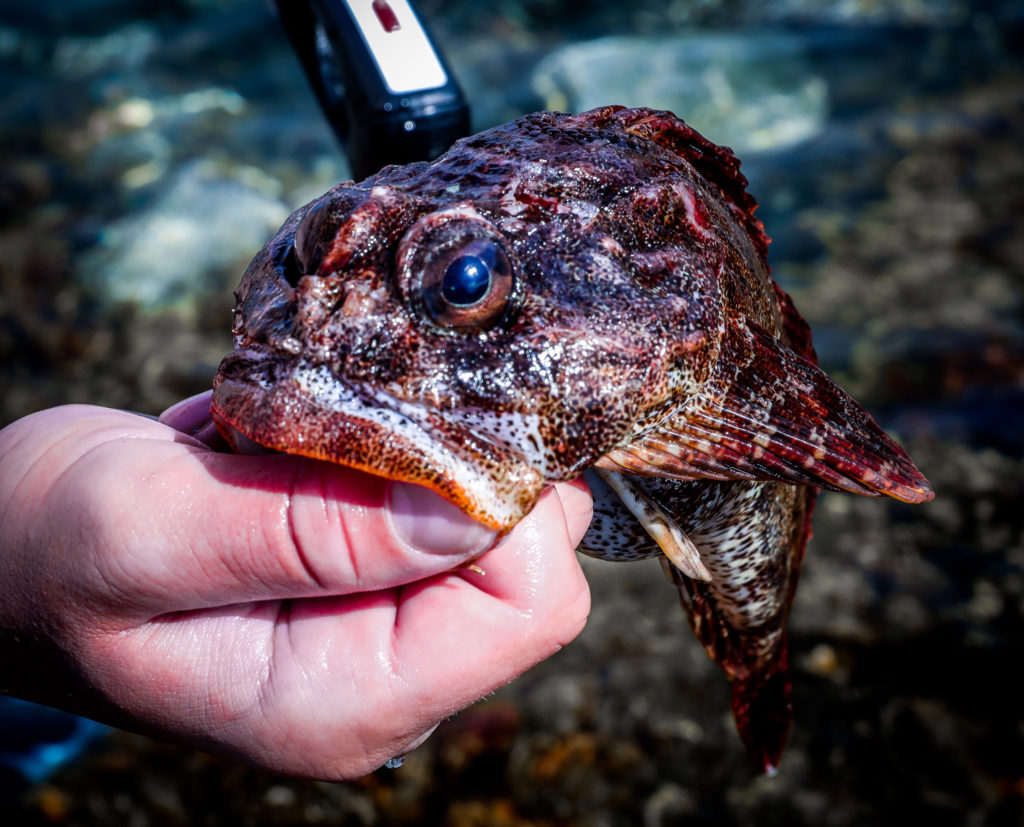The quiet in Sandspit is deafening at times. Don’t get me wrong. I like it. If you’re used to city living, the genuine silence at the edge of the world is a rare and beautiful thing.
Sandspit is a small community – around 250 souls, I’m told – but it is not without life. Haida Gwaii’s small, main airport is here. It is well-run and pleasantly staffed, as is a new and efficient-looking Coast Guard station sitting next to a well-appointed public dock that acts as a jumping off point for sport fishers heading through Skidegate Narrows to the West Coast. There are also young people here, the silence sometimes shattered by the sound of young ones playing, or an older kid zooming past on a dirt bike.

Caysen McDiarmid isn’t a Sandspit resident. He lives across the inlet near Skidegate (pronounced skid-ah-get), but he takes the ferry over here to spearfish from the harbour wall by the boat ramp. I first ran into Caysen at the Bayview Garden Guesthouse, where I was booked in for a few days. He had friends staying there and had appeared one evening with a beautiful Ling Cod which he then deftly prepared and cooked. The fish was large enough that there were leftovers, which he generously donated to myself and another lucky guest.
Having grown up with all the Internet can offer at their fingertips, these young people can make our younger selves seem quaint at best.
We had arranged to meet in the morning but crossed-wires had led to me doing something else for the day: An aborted trip to Skedans, a Haida village in the Gwaii Haanas National Park Reserve and Haida Cultural Heritage Site, that had at least afforded me a view of the massive kelp forest in the shoals off the north east corner of Louise Island. I’d not seen a kelp bed of this magnitude before. It was impressive and alone made the trip worthwhile.
Forward-thinking despite his youth, talking, with Casen made me wonder, “What the heck was I doing at his age?” This self analysis will be familiar to those who actually engage with Post-Millennials, instead of simply deriding them on social media. Having grown up with all the Internet can offer at their fingertips, these young people can make our younger selves seem quaint at best. With university nearing on the horizon, Caysen, if he does see himself coming back to work on Haida Gwaii, sees doing it as a Marine Biologist. What a gift to the archipelago that would be.
Work, Life, Family and Vision
When we finally caught up with each other, Caysen was out of the water and he was standing on the rocks in his hoodie, sweats, rubber boots – pretty standard gear for his age group here. He comes from a fishing family and works a number of fishing related jobs: Offloading commercial and sport fishing boats; fish processing; and fish stock monitoring. He also assists the local salmon hatchery programs, transporting fry (baby salmon that feed on plankton) from the hatchery to the creeks.
The fact that in his spare time he ventures back to the ocean to fish speaks volumes about how much they (the ocean and the creatures in it) are a part of his life. In fact, when I asked him how important fishing and the ocean have been to his education and to forming who he is as a person, his initial response was to laugh. He’s been fishing since he was a kid. Obviously, he can’t separate the two; the ocean is a part of his identity. Part of how he expresses his identity is by catching fish, making them a part of how he survives, becoming one with the cycle.
Caysen is pro eco-tourism, believing that it will be an increasing part of the archipelago’s economic future. He says, “I see Ecotourism as a major pillar of Haida Gwaii’s future economy. Since this way the incredible Ecosystem we have on the coast still generates revenue for the community in a sustainable fashion.” Yet he is aware ecotourism will not be able to provide everything that is required for the sustenance of all, “I think it’s obvious we need to continue in natural resource harvesting, but [in such a way that is has] less impact. Such as replacing clear-cut logging with selective logging, but this is difficult since it must also be economically viable.”
“Species go extinct or scarce and the effect of that missing piece is felt throughout the ecosystem and eventually returns to us as a smaller cheque than the year before.”
He questions fish management policy that increase commercial quotas while restricting recreational limits. He recognizes the apparent mental acrobatics required for an official to say, “You people can’t fish to feed yourselves, but these other people can fish to feed other people for profit…I think that, no matter what, the right of food fishing should be held above the desires of any money hungry commercial forces. This is less common on the British Columbian coast and would better fit the description of Omega Protein and the menhaden fish.”
Caysen has one sibling, a brother, and when I ask him how many nights a week one of the family brings home a fish for the table, he says, “three or four.” Roughly half the time. This direct link between ocean and table; the availability of fish and the way a household of two boys is run; is inspiring and slightly surreal to someone like me who has only lived with food that comes already gutted, skinned, often deboned and almost always packaged. You can talk all you want about food security, but here it is in action. As long as there are fish to catch. These are the reasons why Caysen can work fishing boats and fish stock replenishment without any sense of irony.
Cycle of Life
On this note, Caysen says,”We rely so heavily on healthy natural resources here… destroying it and not doing anything to lead to its restoration results in an unsustainable environmental situation. An ecosystem, such as the marine ecosystem here on Haida Gwaii, is so delicately balanced that any action to harm it [including actions that beneift the economy] shifts that balance. Species go extinct or scarce and the effect of that missing piece is felt throughout the ecosystem and eventually returns to us as a smaller cheque than the year before. So, doing work in an attempt to restore balance such as salmon broodstock seems like a natural part of looking after the ecosystem that upholds my entire community.”
For Caysen, you get the impression that these are all just parts of the same cycle, with human beings having their place just like everything else. His father worked for a few seasons as a commercial fisherman before going to work doing environmental monitoring for the Department of Fisheries and Oceans (DFO.) This dual set of professions in the fishing industry is something that used to happen often but now seems to be a thing of the past. Older commercial fishermen, notably Des Nobels, have underscored this link to me; the importance of having experienced fishermen at the DFO. This transference of knowledge used to catch fish also used to help maintain the health of the oceans. Now, according to fishermen we have spoken with, mainly bureaucrats man the ship, so to speak.

It makes me think that this may be just as important to the economic future of coastal areas: If we value the ocean, we should be prepared to pay for its protection, and who better to give that work to than fishermen who are competing for space in a shrinking industry? How many of them could bear to work for the government is another matter, but perhaps a solvable one.
Caysen isn’t the picture of what’s wrong on our coast. He is the very picture of much that is right, and of conservation to come.
To go from active fisherman to government overseer is a bigger switch in self-image than outsiders might think: The transition from independent hunter of the sea, a role that once promised great freedom and often great wealth, to what many would see as the role of the bureaucrat. I also wonder if this image problem is one of the Department’s biggest challenges inside and out. If I can find someone from the DFO willing to talk to me, I’ll ask them. Caysen shows me the homemade spear he uses and the fish that his friend just killed using a modern, if beaten-up looking, slingshot style spear-gun. I suspect that it is a rockfish – an “at risk” species, some rockfish are critically endangered in Haida Gwaii – there are strict restrictions on where you can catch them and which species you can take. I eye the fish suspiciously, but lack the knowledge to know if this one is allowed or not. Caysen assures me that it is (later telling me that it is a Cabazon.) Then he guts, skins and fillets the fish skillfully while grumbling in a good-natured way that his knife is not the right type.
I need to improve my fish identification for sure. It crossed my mind that they might be testing me.
Picture This
In retrospect I should have offered to take him out fishing on my boat. I could have, and perhaps he would have appreciated it. In truth, I was happy to get any pictures at all after what had been a difficult few days. Also, I was, with some merit, suspicious of his catch. Having said that, Caysen isn’t the picture of what’s wrong on our coast. In many ways he is the picture of what is right, and gives clues to conservation to come. He embodies a kind of life that many sophisticated city types aspire to be without ever getting their hands bloody. Authentic, minimum impact, sustainable and renewable.
Caysen sees the North American consumer lifestyle of taking more than one needs, and he lives his life opposite of that. He says, “I think that the health of our ocean is influenced by choices we make every day with basically every action, especially in our consumer-based society. This need for more material goods puts strain on the natural resources used in that item’s production, transport, and often when it is thrown away after one use… and finds its way into our oceans.”
Amidst the wilderness of Haida Gwaii, where prosperous industries can turn off like the flick of a switch, this is an image of the West Coast that is worth protecting and nurturing for the rest of time.


